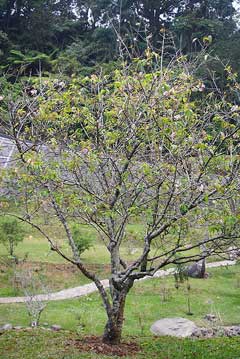
Wild Himalayan Cherry
Latin Name: Prunus cerasoides
USDA Hardiness: 7-10
Native Range: TEMPERATE ASIA: China (Xizang Zizhiqu (south), Yunnan Sheng (northwest)) TROPICAL ASIA: Bhutan, India (Sikkim, Himachal Pradesh, Jammu and Kashmir, Meghalaya, Tamil Nadu, Uttar Pradesh, West Bengal, Mizoram), Sri Lanka, Nepal, Laos (north), Myanmar, Thailand (north), Vietnam (north)
Edibility Rating: 2 / 5
Medicinal Rating: 2 / 5
Region:
Family:
Plant Type:
Medicinal Uses
Edible Uses
Edible Parts: Fruit Seed | Edible Uses: GumFruit - raw or cooked[51, 105, 158, 272]. Acid and astringent, they are only occasionally eaten raw but are more often cooked[183]. The fruit is about 15mm in diameter and contains one large seed[200]. Gum - chewed. Obtained from the trunk, it can be employed as a substitute for gum tragacanth[183], see Astragalus spp. Seed - raw or cooked. Do not eat the seed if it is too bitter - see the notes above on toxicity.
Cultivation
Thrives in a well-drained moisture-retentive loamy soil[11, 200]. Prefers some lime in the soil but is likely to become chlorotic if too much lime is present[1]. Requires an open sunny sheltered position[166]. Not very hardy in Britain[1] but it succeeds outdoors in the milder areas of the country[166]. Most members of this genus are shallow-rooted and will produce suckers if the roots are damaged[238]. Plants in this genus are notably susceptible to honey fungus[200].
Known Hazards
Although no specific mention has been seen for this species, it belongs to a genus where most, if not all members of the genus produce hydrogen cyanide, a poison that gives almonds their characteristic flavour. This toxin is found mainly in the leaves and seed and is readily detected by its bitter taste. It is usually present in too small a quantity to do any harm but any very bitter seed or fruit should not be eaten. In small quantities, hydrogen cyanide has been shown to stimulate respiration and improve digestion, it is also claimed to be of benefit in the treatment of cancer. In excess, however, it can cause respiratory failure and even death.
Habitats
Forests, 1200 - 2400 metres[51]. Forests in ravines at elevations of 700 - 3700 metres in western China[266].
